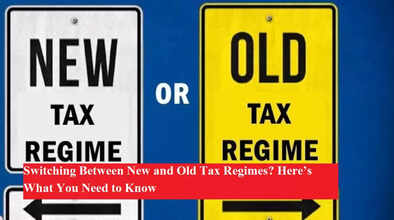New Tax Regime vs Old Tax Regime Rules: Switching Between New and Old Tax Regimes? Here’s What You Need to Know

New Tax Regime vs Old Tax Regime Rules: Thinking about switching from the new tax regime to the old one or vice versa? You’re not alone. Every year, taxpayers often evaluate which tax system will save them more money. While the government does allow switching between regimes, the rules aren’t the same for everyone. Here’s a complete breakdown of who can switch, how often, and what conditions apply.
What Are the Tax Regimes?
The Indian government introduced the New Tax Regime in 2020, offering lower tax rates but eliminating most deductions and exemptions available under the Old Tax Regime. As you prepare to file your Income Tax Return (ITR) for 2025, you’ll have to choose between the two systems based on your income structure.
However, your ability to switch between the regimes depends largely on the source of your income.
Income from Salary, Interest, or Rent
If your earnings come from salary, interest, house rent, or any other non-business sources, good news — you have the flexibility to switch every year.
-
You can assess both tax regimes annually and choose the one that offers maximum tax savings.
-
However, your choice must be made before filing your ITR.
-
There’s no restriction on how many times you can move between the new and old regimes if your income doesn't include business or professional income.
This flexibility allows salaried individuals and pensioners to optimize their tax liability every financial year.
Income from Business or Profession
If you earn your income through business or professional activities, the rules for switching are much stricter:
-
You can initially opt for the new tax regime by submitting the required form.
-
If you later decide to return to the old regime, you can switch only once in your lifetime.
-
After you move back to the old regime, you are not allowed to switch to the new regime again in the future.
-
To make this switch, you must submit Form 10-IEA before filing your ITR.
Thus, business owners and professionals need to think carefully before making a switch because it’s mostly a one-time decision.
New Tax Regime Is Now the Default
Under the Finance Act 2023, the New Tax Regime has become the default tax system:
-
If you do not explicitly choose the old tax regime while filing your return, you will automatically be considered under the new tax regime.
-
However, you still have the option to switch to the old regime by timely submitting Form 10-IEA before filing your taxes.
This change was made to simplify the tax filing process, but it’s important for taxpayers to be aware of their choices to avoid unintended defaults.
Quick Recap: Switching Rules at a Glance
| Income Source | Switching Allowed | Conditions |
|---|---|---|
| Salary / Interest / Rent | Every year | Decide before filing ITR |
| Business / Professional Income | Only once | File Form 10-IEA, no switching back to new regime |
Final Words
Choosing between the old and new tax regimes isn’t just about lower tax rates — it’s about how much you can actually save based on your eligible deductions, exemptions, and income profile. Salaried taxpayers have the luxury of switching every year, but business owners must tread carefully.
Always evaluate your income structure, calculate your potential tax liability under both systems, and make an informed choice. If in doubt, consult a tax advisor to ensure you don’t miss out on legitimate savings.
Remember: Your tax regime choice can significantly impact your financial planning for the year!

